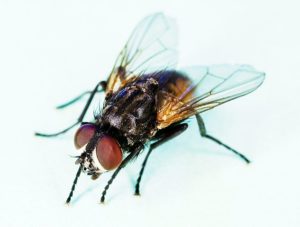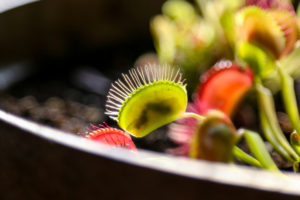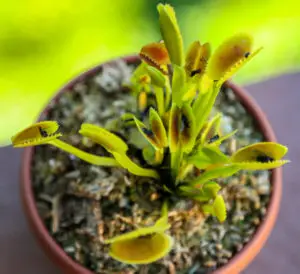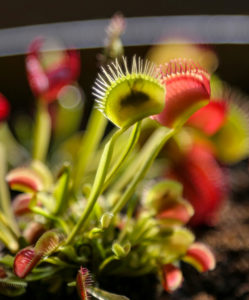| We are a participant in the Amazon Services LLC Associates Program, an affiliate advertising program designed to provide a means for sites to earn advertising fees by advertising and linking to Amazon.com. |
You can feed venus flytraps dead bugs. It’s important to understand however, it’s more of a process than just allowing the trap to close and walking away. Feeding a venus flytrap dead bugs is more of a manual process. Venus fly traps releases digestive enzymes when a secondary response is triggered inside the trap after it closes. After the trap closes you must gently massage the flytrap head to trick the trap into thinking that the insect inside is alive. This will trigger the digestive enzymes to breakdown and absorb the insect.
Lets get into a deeper discussion about how this works and why venus flytraps are an absolute evolutionary marvel. Lets talk about size, type and how to feed a venus flytrap a dead bug.
Buy Carnivorous Plants Online!
Table of Contents
Pinterest
Facebook
Twitter
Reddit
Can You Feed Venus Flytraps Dead Bugs?
Venus flytraps are truly an evolutionary marvel. The process to feed venus flytraps dead bugs is just one of the many examples of how extraordinary they are. Before we get into the why, let me explain the process you need to follow to make sure that a venus flytrap digests a dead bug or insect.
It should be noted that it’s almost always better to feed your venus flytrap a live bug instead of a dead bug. Although its 100% possible to feed it a dead bug, if you have a live alternative, I’d definitely go with that. One of the best live bugs you can get easy and cheap are meal worms. They are one of the best options if you want to have live bugs on hand to feed.
If dead bugs are the only option for feeding your venus flytrap, keep reading so you can learn about what time, what size and how to feed a venus flytrap a dead bug.
What Kind Of Dead Bug Or Insect
Before we jump into how to do feed a venus flytrap dead bugs, lets talk about the kind of dead bugs you should be picking out. You want to search for a bug or insect that has a soft exoskeleton. Anything with a super hard shell can be problematic for the venus flytrap to digest. Large beetles with hard shells will be difficult for the venus flytrap to digest. The end result is often the flytrap head dying because the hard shelled beetle is just too much.

A common house fly might be the best option for a venus flytrap.
A common house fly really is the perfect insect for a venus flytrap to munch on. They are soft and dissolve really well when the venus flytrap releases its enzymes. Most spiders work really well as they are softer bodied insects. Meal worms are an excellent insect to feed flytraps. They do have a bit of a harder outside, but not so hard that they can’t be dissolved. Mealworms are actually my favorite meal to feed venus flytraps. Alive and dead, they are great!
Avoid anything that is overly squishy or really wet. Leaches, slugs, earth worms are all terrible for feeding venus flytraps. Venus flytraps can definitely break them down but this often results in the trap turning black and dying. There is just too much moisture. The insect will develop mold and mildew and eventually take out the flytrap. They really aren’t evolutionary designed to eat slimy wet insects.
Correct Size Of Dead Bug or Insect
Picking out the right type of insect is important but also finding the right size can be just as important. A venus flytrap must form a good seal when closing down on an insect. If an insect is too large, a seal cannot be completed and it will have a really hard time breaking the insect down. 
You should never feed your venus flytrap anything that is more than 1/3 it’s size. Keeping it around this size ensures that there is enough insect to justify the plant going through its process to break the bug down. But it’s also not so large that the venus flytrap will have a hard time sealing around it.
Feeding The Venus Flytrap A Dead Bug
Now that you swatted down the perfect type and size dead insect to feed your venus flytrap, lets get started.
At first, you will feed it just like you do a live insect. Place the insect inside the trap head, try to center it as best as possible. Putting the insect in the trap may trigger it, if not, simply use your finger to touch the trigger hair inside the trap. There are typically 3 small hairs that are the trigger. If it’s too small, just rub your finger or something small along the inside of the trap head, it will eventually close.

Once the trap closes, you will want to gently massage the outside of the trap for about 30 seconds to a minute. Venus flytraps will not release their digestive enzyme unless the secondary response is triggered. It’s not good enough to just make the trap close. If you did this correctly, you will see a seal begin to develop around the insect in about 30 minutes. If no seal forms, this means the flytrap will likely open up in the next few days and not actually breakdown and use the insect.
Keep reading below why the venus flytrap needs the secondary response in order to release it’s digestive enzymes.
How A Venus Flytrap Works While Feeding
Venus flytraps are truly incredible when you really start to analyze their evolutionary traits, even when it comes to eating dead bugs. The secondary trigger was developed because venus flytraps waste a lot of energy trying to digest an insect. If there isn’t an actual insect inside the trap, it can die from wasting so much energy without replenishing what it lost with the insect.

Imagine a raindrop or falling leaf fall into a venus flytrap. It closes and releases its enzymes but receives nothing in return. The amount of energy a flytrap puts out trying to breakdown and absorb an insect is a lot. Over time, venus flytraps developed a secondary response as a fail safe in the event that they are triggered by anything other than an insect.
I try to imagine the amount of flytraps that died over so many years before it started to realize that in order to survive long term, it needs to adapt and stop trying to absorb without knowing for sure that it has a live insect.
That insect on the inside wiggling around is the secondary trigger the plant needs to start producing its enzymes and breaking down the insect to absorb what it needs!
Conclusion
When it comes down to it, I strongly recommend feeding a venus flytrap live bugs. However, if live bugs are not an option it is okay and possible to feed a venus flytrap a dead bug or insect. It’s a little more work on your part, but if done correctly the venus flytrap will never know if it’s absorbing nutrients from a live or dead bug.
If you would like to learn more about venus flytraps and how to care for them, check out the video below. It’s a full venus flytrap care guide, from A to Z. Make sure to subscribe to the Carnivorous Plant Hub YouTube channel for more great videos!


